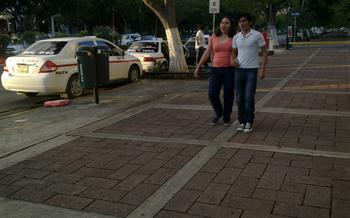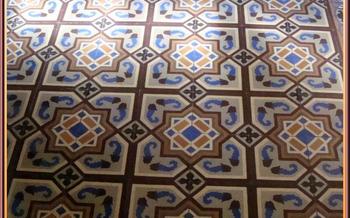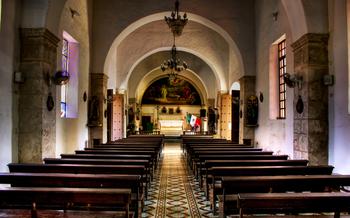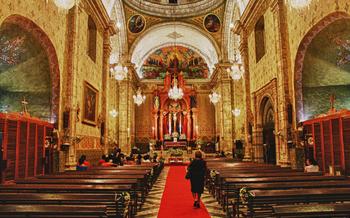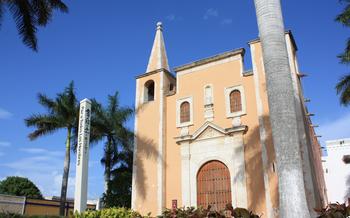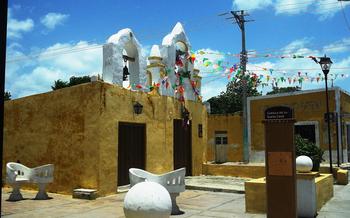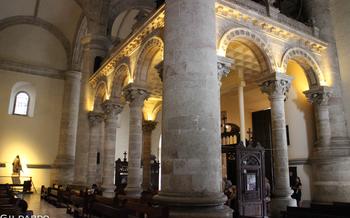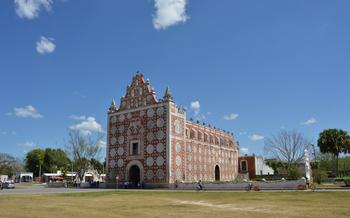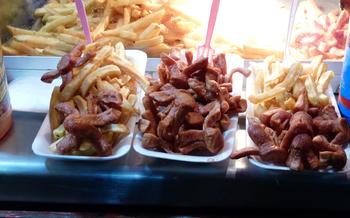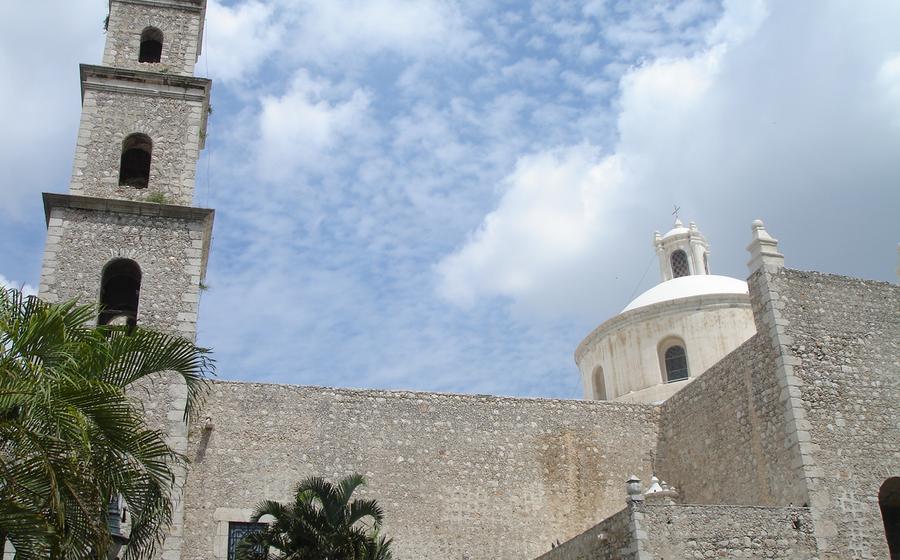
Iglesia de la Tercera Orden
- Tercera Orden
- Location and Accessibility
- Opening Hours and Admission
- Guided Tours
- Highlights of the Interior
- Cultural Significance
- Photography and Videography
- Dress Code and Etiquette
- Local Festivals and Events
- Unique Experiences
- Accessibility for Disabled Visitors
- Local Cuisine and Restaurants
- Souvenirs and Shopping
- Insider Tip: Discover the Hidden Courtyard
Tercera Orden
The Iglesia de la Tercera Orden, also known located in the heart of Merida, Mexico. This magnificent edifice showcases a blend of Renaissance and Baroque styles, featuring a striking facade adorned with intricate carvings and sculptures. Its unique octagonal-shaped dome, a rare feature in Mexican architecture, is an iconic landmark that dominates the city's skyline.
The church's interior is equally impressive, boasting an awe-inspiring altar and intricate carvings that narrate the life of Saint Francis of Assisi. The church's unique design and impressive artistic details make it a must-visit destination for anyone interested in history, architecture, or culture.
Location and Accessibility
The Iglesia de la Tercera Orden is conveniently located in the heart of Merida's historic center, at Calle 60 #491 x 57, Merida, Yucatan, Mexico. Its prime location makes it easily accessible on foot or by public transportation. For those arriving by car, there are several nearby parking options, including metered street parking and private lots.
The church is situated within walking distance of many other attractions, including the Plaza Grande, Merida Cathedral, and the Palacio de Gobierno. Visitors can easily combine a visit to the Iglesia de la Tercera Orden with a tour of these other landmarks, creating a comprehensive exploration of Merida's rich cultural and historical heritage.
Opening Hours and Admission
The Iglesia de la Tercera Orden is open to the public from Monday to Saturday, from 9:00 AM to 6:00 PM, and on Sundays from 10:00 AM to 2:00 PM. Visitors are welcome to enter the church freely, without any admission fee. However, donations are greatly appreciated to support the upkeep and maintenance of this magnificent historical landmark.
It is important to note that the church may occasionally be closed for special events, religious ceremonies, or restoration work. Therefore, it is advisable to check the church's official website or contact the local tourism office for the most up-to-date information on opening hours and any potential closures.
Guided Tours
The Iglesia de la Tercera Orden offers guided tours in both English and Spanish, providing visitors with an in-depth understanding of its history, architecture, and cultural significance. These tours typically last around 45 minutes and are led by knowledgeable guides who can answer any questions you may have.
The cost of a guided tour is typically around $10 USD per person, and it includes admission to the church. Tours can be booked in advance online or through your hotel concierge.
Taking a guided tour of the Iglesia de la Tercera Orden is a great way to learn more about this fascinating church and its role in the history of Merida. The guides are passionate about their subject and will share interesting stories and anecdotes that you wouldn't hear if you were exploring independently.
Highlights of the Interior
The interior of the Iglesia de la Tercera Orden is a testament to the artistry and craftsmanship of its builders. The eye is immediately drawn to the stunning altarpieces, which are adorned with intricate carvings, gold leaf, and religious iconography. The main altarpiece, dedicated to the Holy Trinity, is a masterpiece of Baroque art and features life-sized sculptures of the Father, Son, and Holy Spirit.
The walls of the church are lined with intricate carvings and decorative elements, which depict scenes from the Bible and the lives of the saints. The ceiling is adorned with beautiful stained glass windows, which depict religious scenes and symbols. The windows filter the sunlight, creating a warm and inviting atmosphere within the church.
The church also houses a number of other religious artifacts, including a collection of silver chalices and candlesticks, a wooden crucifix, and a statue of the Virgin Mary. These artifacts are a testament to the church's rich history and its importance to the Catholic community of Merida.
Cultural Significance
The Iglesia de la Tercera Orden stands as a testament influences. Constructed in the 17th century, this architectural marvel reflects the merging of two distinct worlds, showcasing the harmonious synthesis of indigenous and European traditions.
The church's design incorporates elements from both cultures, resulting in a unique blend of styles. The intricate carvings and decorative motifs, inspired by Mayan artistry, adorn the walls and altars, adding a touch of local heritage to the predominantly Spanish architectural style.
The church's cultural significance extends beyond its physical structure. It served as a pivotal site for religious and cultural exchange, where Mayans and Spaniards converged to celebrate their beliefs and traditions. Over the centuries, the church became a symbol of unity and harmony, fostering a sense of community among the diverse population of Merida.
The integration of indigenous and European influences in the Iglesia de la Tercera Orden is not merely a historical coincidence but a testament to the enduring legacy of cultural exchange in Merida. The church stands as a poignant reminder of the city's vibrant past, where two distinct cultures intertwined to create a unique and enduring cultural identity.
Photography and Videography
Photography and videography are permitted inside the Iglesia de la Tercera Orden, but visitors should be respectful of the religious nature of the site. Flash photography is not allowed, as it can be disruptive to ongoing services or ceremonies. Tripods and other photography equipment are generally permitted, but visitors should be mindful of not obstructing the pathways or blocking the views of other visitors.
To capture the best shots of the church's interior, try to visit during the morning or afternoon when the natural light is most favorable. The intricate carvings and decorative elements are particularly striking when illuminated by the warm glow of the sun. For capturing the exterior of the church, the late afternoon or evening hours can offer beautiful lighting conditions, especially when the sky is clear and the church is bathed in the golden hues of sunset.
Dress Code and Etiquette
When visiting the Iglesia de la Tercera Orden, it is essential to dress appropriately and behave respectfully, as it is a sacred religious site. Visitors should wear clothing that covers their shoulders and knees, avoiding shorts, tank tops, or revealing outfits. While inside the church, it is customary to maintain silence and refrain from talking loudly or disruptive behavior. Photography and videography are allowed, but using flash or tripods is generally prohibited. Visitors should also be mindful of the local customs and traditions, such as removing their hats when entering the church and avoiding pointing their feet towards the altar. It is important to remember that the church is a place of worship, and visitors should conduct themselves accordingly.
Local Festivals and Events
The Iglesia de la Tercera Orden is not just a place of worship but also a venue for various cultural and religious events throughout the year. One of the most significant celebrations is the annual festival honoring the Virgin of Guadalupe, the patron saint of Mexico. Held on December 12th, this festival attracts thousands of devotees who gather to pay homage to the Virgin. The church is adorned with colorful decorations, and there are processions, masses, and traditional dances to mark the occasion.
Another notable event is the Holy Week procession, which takes place during Easter. The streets surrounding the church are transformed into a vibrant spectacle, as locals and visitors alike participate in the procession, carrying religious icons and enacting scenes from the Passion of Christ. These events offer a unique opportunity to witness the deep religious traditions and cultural heritage of Merida, making a visit to the Iglesia de la Tercera Orden even more enriching and memorable.
Unique Experiences
One of the most unique experiences visitors can have is attending a mass or religious ceremony at the Iglesia de la Tercera Orden. This is a great way to immerse yourself in the local culture and witness the devotion of the Mexican people. Masses are held daily in Spanish, and visitors are welcome to attend.
If you're fortunate enough to be in Merida during one of the many religious festivals, you'll have the opportunity to experience the church in its full glory. These festivals often feature special processions, music, and dancing. It's a great way to see the church come alive with activity and celebration.
For a truly unforgettable experience, you can even arrange to have a private tour of the church. This is a great way to learn more about the history and architecture of the church, as well as its role in the religious and cultural life of Merida. Private tours can be arranged through the church office.
Accessibility for Disabled Visitors
The Iglesia de la Tercera Orden is committed to ensuring that all visitors have a welcoming and accessible experience. The church features several accessibility features to accommodate disabled visitors, including wheelchair ramps at all entrances and designated seating areas within the church. Additionally, the church staff is trained to assist visitors with disabilities and provide any necessary accommodations. Visitors who require assistance or have questions about accessibility are encouraged to contact the church in advance.
Local Cuisine and Restaurants
After exploring the grandeur of the Iglesia de la Tercera Orden, take a culinary journey and savor the flavors of Merida's rich cuisine. Just a short walk from the church, you'll find a delightful array of restaurants and cafes, each offering a taste of the Yucatan's culinary heritage.
For an authentic experience, try "La Chaya Maya," a charming restaurant known for its traditional Mayan dishes. Indulge in the flavors of "cochinita pibil," a slow-roasted pork dish infused with achiote paste and wrapped in banana leaves. Another must-try is "panuchos," a dish featuring fried tortillas topped with black beans, shredded turkey, and pickled red onions.
If you prefer a more contemporary dining experience, head to "Apoala," a stylish restaurant that fuses traditional Yucatecan cuisine with modern culinary techniques. Here, you can savor dishes like "ceviche de pescado," a refreshing ceviche made with fresh fish, lime juice, and habanero peppers. For a unique twist on traditional Yucatecan flavors, try the "pulpo al pastor," grilled octopus served with a pineapple-achiote marinade.
No visit to Merida is complete without trying the local street food. For a taste of authentic Yucatecan flavors, head to the "Mercado de San Benito," a bustling market filled with food stalls. Here, you can sample regional delicacies such as "salbutes," fried tortillas topped with turkey or chicken, and "tortas de cochinita," sandwiches filled with slow-roasted pork.
Whether you choose to dine in a traditional restaurant, a contemporary eatery, or indulge in street food delights, Merida's culinary scene offers a feast for the senses. Embrace the flavors and aromas of this vibrant city, and let your taste buds experience the magic of Yucatan cuisine.
Souvenirs and Shopping
After exploring the beauty of the Iglesia de la Tercera Orden, visitors can take home a piece of its history and spirituality by purchasing souvenirs and local products. Several shops and stalls are clustered near the church, offering a wide variety of souvenirs, crafts, and religious items.
For those seeking authentic Yucatecan mementos, look for intricate hand-woven textiles, colorful ceramics, and intricate wood carvings. These handcrafted products showcase the region's rich cultural heritage and make for meaningful gifts or home décor pieces.
Religious souvenirs are also readily available, such as rosaries, crucifixes, and small statues of saints. Visitors can purchase these items as keepsakes or as tokens of their visit to the church.
When shopping for souvenirs in Merida, it is recommended to explore the traditional markets, such as the Mercado Lucas de Gálvez or the Mercado de Artesanías, where local vendors display a diverse array of handicrafts and souvenirs at affordable prices. Bargaining is customary in these markets, so visitors can engage with the friendly vendors and try their hand at negotiating for the best deals.
Insider Tip: Discover the Hidden Courtyard
Venture beyond the main sanctuary of the Iglesia de la Tercera Orden to discover a hidden gem—a serene courtyard tucked away from the bustling streets. This tranquil oasis offers a moment of respite from the city's vibrant energy. Admire the delicate archways, lush tropical plants, and intricate tilework that adorn the courtyard, creating a picturesque setting for contemplation or simply enjoying the peaceful ambiance.
